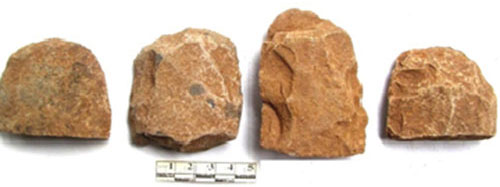Discovering vestiges of caverns in Tuyen Quang
For the first time, Vietnamese scientists found the relics of the late post-Stone cultural inhabitants about 4,000 years ago.
Associate Prof. Nang Nang Chung, Head of the survey team of the Institute of Archeology and Tuyen Quang Museum said that archaeologists have discovered many cultural vestiges of cavernous people in the limestone mountains of Chiem Hoa district. . These include Pu Chua cave, Minh Quang commune and Hang Ngan, Monkey cave, Phuc Son commune.
This is the first time that archaeologists have discovered the relics of post-Neolithic cultural inhabitants in the cave in Chiem Hoa and Tuyen Quang districts.

Stone tools and pieces of pottery found in Pu Chua cave.
At Pu Chua cave , at a depth of 0.4m, archaeologists found many stone and ceramic relics. In it, a set of relics consisted of nearly ten polished stone axes, including quadrilateral axes, two shoulder axes and one shoulder ax. The pieces found here are mainly made with a turntable, only some pieces with traces are hand-held.
Based on the overall study of relics and sedimentary strata of cultural strata, the researchers initially said that Pu Chua cave has a relic of prehistoric people, dating back about 4,000 years ago.

Stone tools found in Ngan cave.(Photo: NVCC).
At Ngan cave and Monkey cave surveyed on the surface, the survey team discovered nearly ten stone chipping tools, including rough cutting and scraping tools. These are rudimentary labor tools that are versatile of prehistoric people.
According to Prof. Trinh Nang Chung, from the relics discovered, Chiem Hoa is a land with archaeological potential.
"We are planning to explore the Pu Chua cave and survey the entire limestone area of Chiem Hoa district in the near future" , Associate Professor Chung said.
Recently, Vietnamese archaeologists have continuously discovered traces of the history of prehistoric people. It is the remains discovered with many relics 4,000 years ago found during the process of architectural remodeling at Tham Temple (Bac Kan) in late July.
Or as prehistoric bones 7,000 years ago also discovered in Dak Nong has just announced in September.
These findings have implications in science, adding to the reenactment of the period of activity and living of prehistoric people.
The Neolithic Age is a period of the Stone Age in the history of human technology development.
The great progress of the Stone Age was the human species who knew the true cultivation. In the Natufian cultures in the pre-Neolithic period, wild grains were harvested, and early seeding and re-planting occurred.
- Discovering an ancient village of 3500 years old at Bai Soi, Tuyen Quang
- Tuyen Quang: Discovering many ancient monuments in Son Duong
- Discovering more relics of the temple in Tran Dynasty in the XIII-XIV century in Tuyen Quang
- Discovered a prehistoric tomb in Tuyen Quang
- Discover an ancient religious relic in Tuyen Quang
- Tuyen Quang: Discovered the ancient wreck in the Lo River
- Discovering a hundred million year old crater in Quang Ngai
- Archaeological findings 2012 - Ancient coins in Tuyen Quang
- Discover a unique way of shroud in Tuyen Quang
- Discovering many cultural relics of primitive people in Tuyen Quang
- Conservation of populations of white cheeked black langurs in Tuyen Quang
- Hail is the largest in 30 years in Tuyen Quang
 Discovered an ancient centipede fossil 99 million years old
Discovered an ancient centipede fossil 99 million years old Discovered bat-like dinosaurs in China
Discovered bat-like dinosaurs in China Discovered a 200-year-old bronze cannon of the coast
Discovered a 200-year-old bronze cannon of the coast Discover 305 million-year-old spider fossils
Discover 305 million-year-old spider fossils